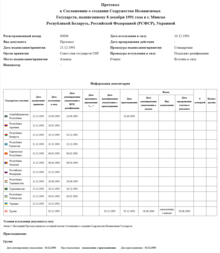Our website is made possible by displaying online advertisements to our visitors.
Please consider supporting us by disabling your ad blocker.
Alma-Ata Protocol
 L–R: Ukrainian President Leonid Kravchuk, Kazakh President Nursultan Nazarbayev, Russian President Boris Yeltsin, and Belarusian leader Stanislav Shushkevich after signing the treaty | |
| Type | Treaty establishing a founding declarations and principles of the Commonwealth of Independent States (CIS). |
|---|---|
| Signed | 21 December 1991 |
| Location | Alma-Ata, Kazakhstan, Soviet Union |
| Effective | 21 December 1991 |
| Signatories |
|

The Alma-Ata Protocols were the founding declarations and principles of the Commonwealth of Independent States (CIS). The leaders of Russia, Ukraine, and Belarus had agreed to the Belovezha Accords on 8 December 1991, declaring the Soviet Union dissolved and forming the CIS. On 21 December 1991, Armenia, Azerbaijan, Belarus, Kazakhstan, Kyrgyzstan, Moldova, Russia, Tajikistan, Turkmenistan, Ukraine, and Uzbekistan agreed to the Alma-Ata Protocols, formally establishing the CIS. The latter agreement included the original three Belavezha signatories, as well as eight additional former Soviet republics. Four former Soviet republics did not participate: Georgia, and the three Baltic states of Lithuania, Latvia and Estonia. The Baltic states consider their incorporation into the USSR in 1940 as illegal.[2]
The protocols consisted of a declaration, three agreements and separate appendices. In addition, Marshal Yevgeny Shaposhnikov was confirmed as acting Commander-in-Chief of the Armed Forces of the Commonwealth of Independent States. Separate treaty was signed between Belarus, Kazakhstan, Russia, and Ukraine "about mutual measures in regards to nuclear weapons".[3]
The Alma-Ata Protocols removed any doubt that the Soviet Union no longer existed "as a subject of international law and geopolitical reality" (in the words of the Belovezha Accords' preamble), since 11 of the 12 remaining republics had declared that the Soviet Union had dissolved. The signatories preemptively accepted the resignation of Soviet President Mikhail Gorbachev, who told CBS News that he would resign when he saw the CIS was a reality.[4] Gorbachev resigned on 25 December, and the Soviet of the Republics of the Supreme Soviet of the USSR voted the Soviet Union out of existence on 26 December.
- ^ "Протокол к Соглашению о создании Содружества Независимых Государств, подписанному 8 декабря 1991 года в г. Минске Республикой Беларусь, Российской Федерацией (РСФСР), Украиной".
- ^ "THE ALMA-ATA DECLARATION". Federal Research Division / Country Studies / Area Handbook Series / Belarus / Appendix C. Library of Congress. Archived from the original on 22 January 2001.
- ^ (Угода про спільні заходи щодо ядерної зброї). Verkhovna Rada. 21 December 1991
- ^ Clines, Francis X. (22 December 1991). "11 Soviet States Form Commonwealth Without Clearly Defining Its Powers". The New York Times.
Previous Page Next Page


